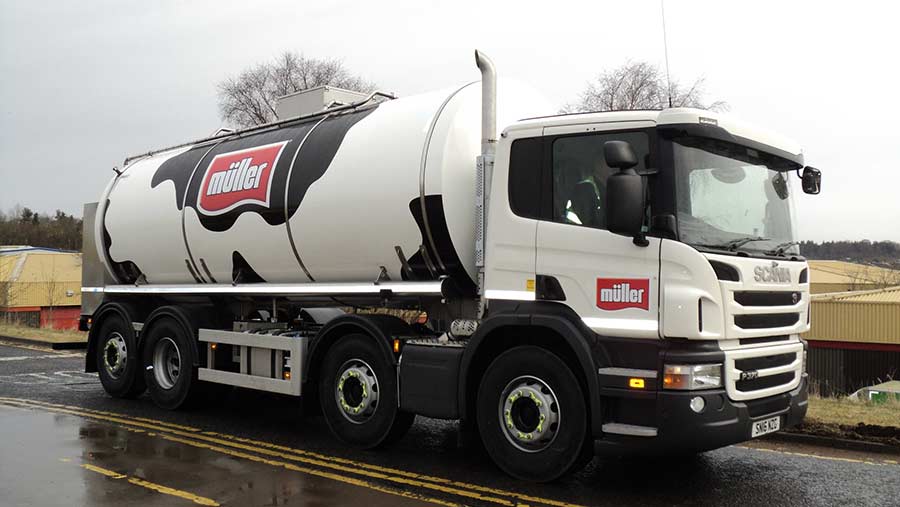3 key ingredients for a milk contract
 Muller milk tanker
Muller milk tanker Many UK dairy farmers are either fully or part way through converting to being paid for full milk solids rather than volume and yet I still see arguments by farmers that it is total volume of solids that counts – it isn’t.
See also: Industry split over a+b milk contracts
In the end, it will be fat plus protein minus volume, so farmers will be penalised for higher water content.
The modern milk contract needs to include the following for both the milk buyer and the milk supplier to benefit:
- Realistic milk hygiene banding payments
- Payments for solids reflecting the ideal percentage mix between butterfat and protein
- Realistic volume controls to avoid over supply.
Put these three together and the dairy industry will reduce the potential boom and bust cycles we seem to be experiencing.
1. Milk hygiene
How can one milk buyer penalise without reward for somatic cell counts (SCCs) above 250,000 cells/ml while another will accept milk at 300,000-400,000 cells/ml for the same end point use?
We have the same challenge with Bactoscans, with some milk manufacturers accepting up to 75,000 parts/ml and others only up to 50,000 parts/ml, but they are receiving the same payment.
Some producers have very low Bactoscans and cell counts achieved at higher labour demands, cow cullings and chemical costs. Such additional costs often go unrewarded and, indeed, on SCC levels can leave a herd or individual cow very susceptible to a high cell count outbreak such as E coli.
The drive to reduce antibiotic use is providing some positive financial benefits on farm. This does, however, demand good milk records and very high levels of hygiene application at the point of drying off.
Therefore, there needs to be a more logical approach when it comes to payments for milk hygiene, and these payments should relate to the end market. For example, organic milk and supermarket liquid contracts should pay for improved and lower SCC and Bactoscans.
2. Payments for solids
Increasingly, milk producers are being paid for the delivery of solids and, in some cases, they are being penalised for water content.
Research from the Netherlands on high-yielding herds and Ireland on lower-yielding cows indicates that about two-thirds of milk quality change is influenced by breeding selection, while the other third is as a result of management and nutrition.
Therefore, farmers must look more at these areas to improve their solids production.
Selection of bulls with plus-percentage increases in butterfat and protein is absolutely essential, while breeding from high-solids cows is also a good idea, provided they are strong and you know the quality of the milk they produce.
Nutrition and management can influence milk quality, but it must be remembered that more solids demands more energy (eg average solids of 4.1% fat and 3.3% protein needs 5.3 MJ/litre, while a 4.5% fat and 3.5% protein may need up to 5.9 MJ/litre, ie an increase of more than 10%).
Total energy intake in a fully fed cow can yield very good solids (but not too much free nitrogen or crude protein), hence the need for high-calibre management alongside the correct genetics.
3. Realistic volume controls
Different milk buyers have different views on how to manage volumes.
Some appear to have no restrictions, while others introduce various caps on volume, from those that are very complicated to those that are very simple.
Following the end of political quotas in 2015, we have seen almost crisis management of volume with no real industry leadership. Some milk buyers are only focused on themselves.
Recent communications on farm have encouraged one set of producers to expand because they had just ‘won’ a new contract.
Well, that contract has only been won at the cost of a loser of the original contract – what happens to that milk? If one is not careful it ends up on the open market going into intervention, lowering the returns for the supplier.
Analysis of supply data clearly shows that in a market where supply rises greater than demand the price falls and vice versa (see table below). Therefore, there is a need to have contracts that control supply.
How supply and demand influences milk price
| Year | 2013/14 | 2014/15 | 2015/16 | 2016/17 |
| Cumulative billions of litres | 13.7 | 14.3 | 14.8 | 14.1* |
| 10 months cumulative actuals | 11.3 | 12.0 | 12.4 | 11.7 |
| Milk price (p/l) | 32.6 | 29.6 | 23.9 | 23.0 |
| Butterfat % | n/a | 4.0 | 4.05 | 4.13 |
| Protein % | n/a | 3.28 | 3.33 | 3.28 |
| Combined kgs of milk solids | n/a | 1.04mt | 1.09mt | 1.05mt |
* Estimates of where we will be at the end of the year
Source: RPA/Defra
